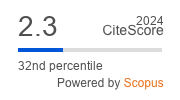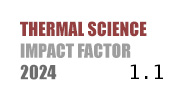THERMAL SCIENCE
International Scientific Journal
IMPACT OF EXTENSIVE GREEN ROOF ON THE REMOVAL OF PARTICULATE MATTER
ABSTRACT
This paper investigates the impact of extensive green roof on ambient PM1, PM2.5, and PM10 concentrations. During summer, particulate matter (PM) concentrations in ambient air were measured above the green roof and reference roof of a school building in the urban environment. The backward trajectory of air mass from the HYSPLIT model was used to access the particle’s emission source. The results show that green roof reduces PM concentration in ambient air by up to 67% and improve the air quality index. The larger impact was observed for PM1 particles, which are the most dangerous for human health. The high correlation coefficients for the ratio of PM2.5/PM10 concentrations were found above both roofs, indicating fine particulate dominance. The findings of this paper can help the large-scale adoption of green roofs to mitigate air pollution.
KEYWORDS
PAPER SUBMITTED: 2025-01-09
PAPER REVISED: 2024-12-07
PAPER ACCEPTED: 2024-12-15
PUBLISHED ONLINE: 2025-01-09
THERMAL SCIENCE YEAR
2025, VOLUME
29, ISSUE
Issue 1, PAGES [629 - 640]
- ***, World Health Organization, WHO Global Air Quality Guidelines: Particulate Matter ( PM2.5 and PM10), Ozone, Nitrogen Dioxide, Sulfur Dioxide and Carbon Monoxide, 2021
- Borck, R., Philipp Schrauth, P., Population Density and Urban Air Quality, Regional Science and Urban Economics, 86 (2021), 103596
- ***, Health Impact of Ambient Air Pollution in Serbia, A Call to Action, WHO Regional Office for Europe
- Thangavel, P., et al., Recent Insights into Particulate Matter (PM2.5)-Mediated Toxicity in Humans: An Overview, International Journal of Environmental Research and Public Health, 19 (2022), 12, 7511
- ***, Report on the State of the Environment in the Republic of Serbia, Republic of Serbia, Ministry of Environmental Protection, Agency for Environmental Protection, www.sepa.gov.rs/index.php?menu=5000&id=1304&akcija=showDocuments&tema=Vazduh
- Viecco, M., et al., Potential of Particle Matter Dry Deposition on Green Roofs and Living Walls Vegetation for Mitigating Urban Atmospheric Pollution in Semiarid Climates, Sustainability, 10 (2018), 7, 2431
- Gaglio, M., et al., Species-Specific Efficiency in PM2.5 Removal by Urban Trees: From Leaf Measurements to Improved Modelling Estimates, Science of The Total Environment, 844 (2022), 157131
- Caetano, P. M. D., et al., The City of Sao Paulo's Environmental Quota: A Policy to Embrace Urban Environmental Services and Green Infrastructure Inequalities in the Global South, Frontiers in Sustainable Cities, 3 (2021), June, pp. 1-16
- Shafique, M., et al., Green Roof Benefits, Opportunities and Challenges - A review, Renewable and Sustainable Energy Reviews, 90 (2018), July, pp. 757-773
- Suszanowicz, D., Wiecek, A. K., The Impact of Green Roofs on the Parameters of the Environment in Urban Areas - A review, Atmosphere, 10 (2019), 12, 792
- Gulia, S., et al., Urban Air Quality Management - A Review, Atmospheric Pollution Research, 6 (2015), 2, pp. 286-304
- Yang, J., et al., Quantifying Air Pollution Removal by Green Roofs in Chicago, Atmospheric Environment, 42 (2008), 31, pp. 7266-7273
- Tan, P. Y., Sia, A., A Pilot Green Roof Research Project in Singapore, Proceedings, 3rd North American Green Roof Conference: Greening Rooftops for Sustainable Communities, Washington, USA, 2005
- Irga, P. J., et al., Biosolar Green Roofs and Ambient Air Pollution in City Centres: Mixed Results, Building and Environment, 226 (2022), 109712
- Arbid, Y., et al., Towards an Experimental Approach for Measuring the Removal of Urban Air Pollutants by Green Roofs, Building and Environment, 205 (2021), 108286
- Li, J., et al., Effect of Green Roof on Ambient CO2 Concentration, Building and Environment, 45 (2010), 12, pp. 2644-2651
- Abhijith, K. V., Kumar, P., Quantifying Particulate Matter Reduction and Their Deposition on the Leaves of Green Infrastructure, Environmental Pollution, 265 (2020), 114884
- ***, IQAir, www.iqair.com/
- ***, World Air Quality Report - IQAir, www.iqair.com/serbia/central-serbia/belgrade?srsltid=AfmBOopLVz04LqpvGZUYnGvQgzst-0LRdSUFQOtpN9xFRqozrNWUd6m5, 2020
- ***, Annual Report on the Results of Air Quality Measurements on the Territory of Belgrade in the Local Network of Measuring Stations, Belgrade City Institute for Public Health, HEAL archive, www.env-health.org/wp-content/uploads/2021/12/AQ_City_briefings_Belgrade.pdf, 2021
- Stein, A. F., et al., The NOAA's HYSPLIT Atmospheric Transport and Dispersion Modelling System, Bulletin of the American Meteorological Society, 96 (2015), 12, pp. 2059-2077
- Kottek, M., et al., World Map of the Koppen-Geiger Climate Classification Updated, Meteorologische Zeitschrif, 15 (2006), 3, pp. 259-263
- Marković, M., et al., Monitoring of Spatiotemporal Change of Green Spaces in Relation the Land Surface Temperature: A Case Study of Belgrade, Serbia, Remote Sensing, 13 (2021), 19, 3846
- ***, balkangreenenergynews.com/temperature-in-belgrade-is-seven-degrees-higher-due-to-lack-of-green-areas
- Badura, M., et al., Evaluation of Low-Cost Sensors for Ambient PM2.5 Monitoring, Journal of Sensors, (2018), 5096540
- Kelly, K. E., et al., Ambient and Laboratory Evaluation of a Low-Cost Particulate Matter Sensor, Environmental Pollution, 221 (2017), Feb., pp. 491-500
- Horn, S. A., Dasgupta, P. K., The Air Quality Index (AQI) in Historical and Analytical Perspective a Tutorial Review, Talanta, 267 (2024), 125260
- Gallo, F., et al., Long-Range Transported Continental Aerosol in the Eastern North Atlantic: Three Multiday Event Regimes Influence Cloud Condensation Nuclei, Atmospheric Chemistry and Physics, 23 (2023), 7, pp. 4221-4246
- Bamola, S., et al., Characterising Temporal Variability of PM2.5/PM10 Ratio and Its Correlation with Meteorological Variables at a Sub-Urban site in the Taj City, Urban Climate, 53 (2024), 101763
- Tolis, E., et al., Chemical Characterization of Particulate Matter (PM) and Source Apportionment Study during Winter and Summer Period for the City of Kozani, Greece, Open Chemistry, 12 (2014), 6, pp. 643-651
- ***, World Health Organization, WHO Global Air Quality Guidelines: Particulate Matter (PM2.5 and PM10), Ozone, Nitrogen Dioxide, Sulfur Dioxide and Carbon Monoxide, 2021
- Abhijith, K. V., Kumar, P., Field Investigations for Evaluating Green Infrastructure Effects on Air Quality in Open-Road Conditions, Atmospheric Environment, 201 (2019), 132e147
- Tong, Z., et al., A Case Study of Air Quality Above an Urban Roof Top Vegetable Farm, Environmental Pollution, 208 (2016), Part A, pp. 256-260
- Marquez, M. I. V., Effectiveness of Green Roofs and Walls to Mitigate Atmospheric Particulate Matter Pollution in a Semi-Arid Climate, Ph. D. thesis, Pontificia Universidad Catolica de Chile School of Engineering, Santiago de Chile, Chile, 2021
- Kostadinović, D., et al., Mitigation of Urban Particulate Pollution Using Lightweight Green Roof System, Energy and Buildings, 293 (2023), 113203
- Guo, L.-C., The Washout Effects of Rainfall on Atmospheric Particulate Pollution in Two Chinese Cities, Environmental Pollution, 215 (2016), Aug., pp. 195-202
- ***, AQI Calculator - US EPA Scale convertor, aqicn.org/calculator

